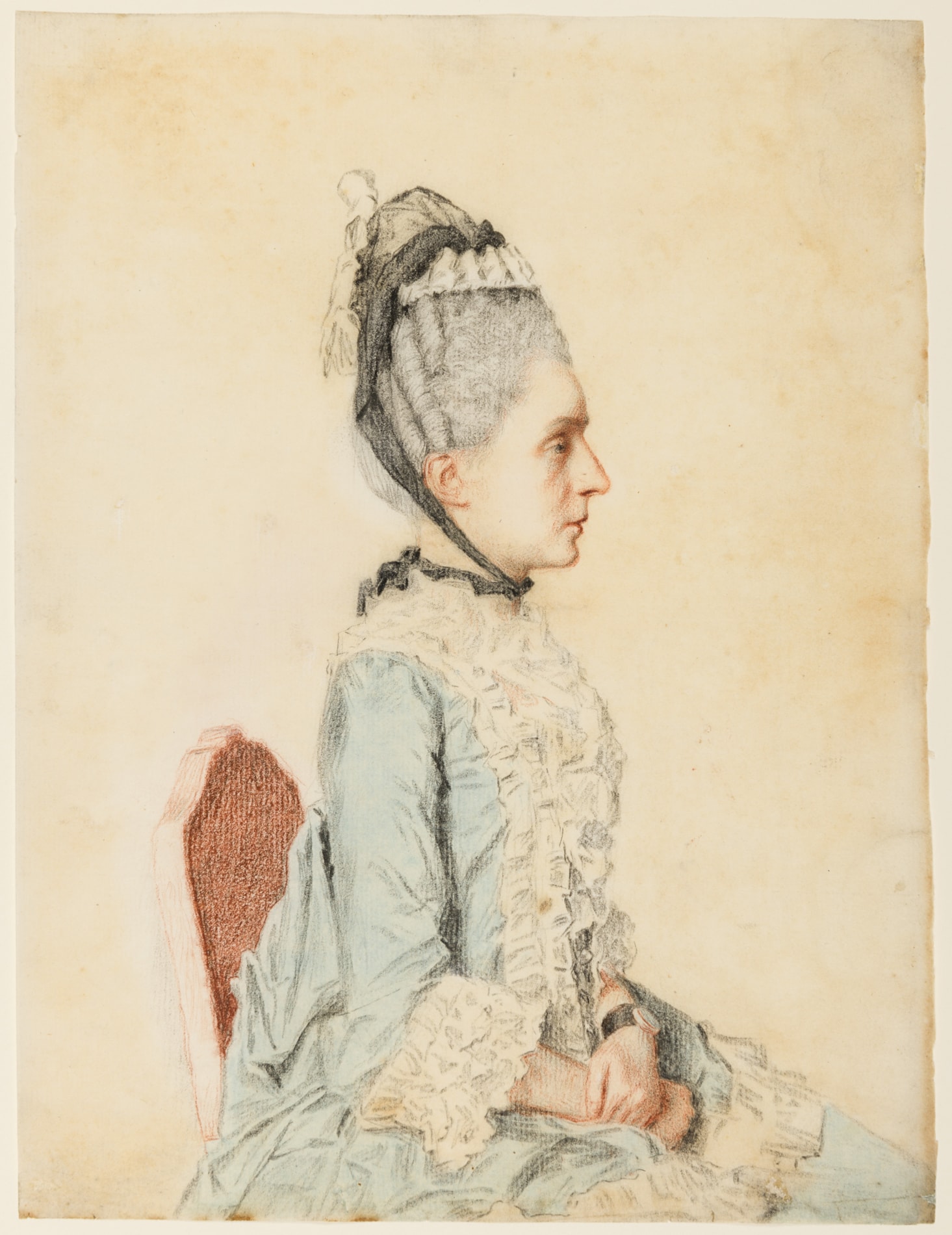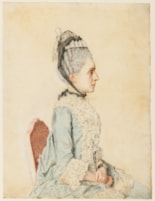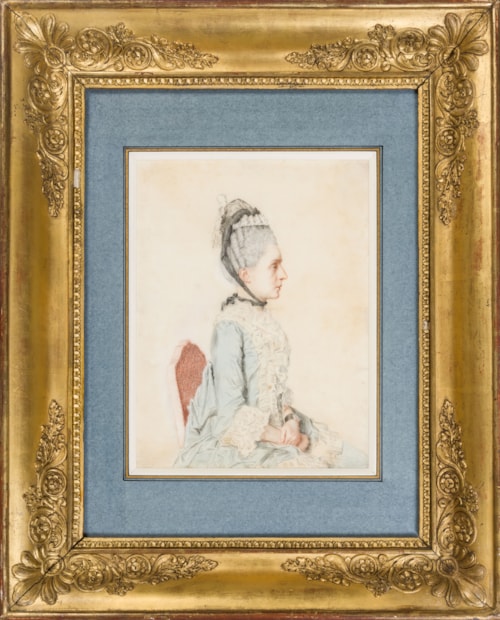Jean-Etienne LIOTARD
(Geneva 1702 - Geneva 1789)
Portrait of a Seated Woman, in Profile to the Right
Sold
Black and red chalk, heightened with white chalk, on white laid paper.
The reverse of the figure partially silhouetted with blue and black chalk on the verso.
228 x 173 mm. (9 x 6 3/4 in.)
The reverse of the figure partially silhouetted with blue and black chalk on the verso.
228 x 173 mm. (9 x 6 3/4 in.)
It has been suggested that this intimate portrait drawing depicts an as-yet unidentified woman from Geneva. The drawing can be dated to the period after 1757, when Liotard and his new wife settled in the Swiss city. On a stylistic basis, the drawing may perhaps be placed more precisely in the late 1770s, by comparison with such works of this date as a profile portrait drawing of the artist’s daughter Marie-Thérèse Liotard of c.1779, today in the collection of the Musée d’Art et d’Histoire in Geneva.
The present sheet is drawn in a combination of coloured chalks on a very thin, almost translucent sheet of white paper. The artist then traced the outlines from the recto onto the verso with slender lines of red and black chalk, before adding larger areas of tone in pale blue and black chalk. The thinness of the paper allows the areas of colouring on the verso to show through onto the recto, thereby creating a greater sense of depth and modelling in the features of the sitter. This precise and refined silhouetting of the figure on the verso of the sheet, creating a ‘negative’ image of the portrait on the recto, is entirely characteristic of Liotard’s working practice during his time in Geneva in the late 1750s and 1760s. As Christian Rümelin has noted of the artist, ‘beginning in 1758, he repeatedly resorted to a method he had already used during his stay in Rome, treating the reverse of relatively thin paper in a technique known from miniature painting. Adding colors to the back of portions of a composition heightens the intensity of those on the front, owing to the slight transparency of the paper. He did not employ this technique systematically, but only in autonomous drawings.’
Many of the artist’s later drawings adopted this novel technique of adding relief to a portrait by reinforcing the image on the verso, such as a profile portrait of Charles-Benjamin de Langes de Monmirail, Baron de Lubières, in the J. Paul Getty Museum in Los Angeles. As Alastair Laing has pointed out, ‘Liotard was a true draughtsman…[with a] relentless proclivity for experiment. One of the most fascinating instances of this is the device that he frequently used to obtain greater translucency and variety of colour in his drawings, without muddying their linear clarity, by washing a repeat image composed simply of taches of colour onto their versos.’
According to an inscription on the former backing board, this drawing was once in the possession of the industrialist Camille Groult (1837-1908), whose impressive collection of 18th century French and English paintings, drawings, pastels and tapestries was kept in his hôtel particulier on the avenue Malakoff in Paris.
According to a label on the former backing board, this drawing was exhibited at the Exposition universelle de 1900: Exposition rétrospective de la ville de Paris at the Musée Carnavalet in Paris in 1900.
The attribution of the present sheet to Jean-Étienne Liotard has been confirmed by both Marcel Roethlisberger and Renée Loche.
The present sheet is drawn in a combination of coloured chalks on a very thin, almost translucent sheet of white paper. The artist then traced the outlines from the recto onto the verso with slender lines of red and black chalk, before adding larger areas of tone in pale blue and black chalk. The thinness of the paper allows the areas of colouring on the verso to show through onto the recto, thereby creating a greater sense of depth and modelling in the features of the sitter. This precise and refined silhouetting of the figure on the verso of the sheet, creating a ‘negative’ image of the portrait on the recto, is entirely characteristic of Liotard’s working practice during his time in Geneva in the late 1750s and 1760s. As Christian Rümelin has noted of the artist, ‘beginning in 1758, he repeatedly resorted to a method he had already used during his stay in Rome, treating the reverse of relatively thin paper in a technique known from miniature painting. Adding colors to the back of portions of a composition heightens the intensity of those on the front, owing to the slight transparency of the paper. He did not employ this technique systematically, but only in autonomous drawings.’
Many of the artist’s later drawings adopted this novel technique of adding relief to a portrait by reinforcing the image on the verso, such as a profile portrait of Charles-Benjamin de Langes de Monmirail, Baron de Lubières, in the J. Paul Getty Museum in Los Angeles. As Alastair Laing has pointed out, ‘Liotard was a true draughtsman…[with a] relentless proclivity for experiment. One of the most fascinating instances of this is the device that he frequently used to obtain greater translucency and variety of colour in his drawings, without muddying their linear clarity, by washing a repeat image composed simply of taches of colour onto their versos.’
According to an inscription on the former backing board, this drawing was once in the possession of the industrialist Camille Groult (1837-1908), whose impressive collection of 18th century French and English paintings, drawings, pastels and tapestries was kept in his hôtel particulier on the avenue Malakoff in Paris.
According to a label on the former backing board, this drawing was exhibited at the Exposition universelle de 1900: Exposition rétrospective de la ville de Paris at the Musée Carnavalet in Paris in 1900.
The attribution of the present sheet to Jean-Étienne Liotard has been confirmed by both Marcel Roethlisberger and Renée Loche.
Born in the-then independent republic of Geneva and trained in the art of miniature painting on enamel, Jean-Étienne Liotard completed his artistic education in Paris, arriving there in 1723 and working as an independent artist by 1726. He soon rose to prominence as a portrait painter, and in fact became known almost exclusively for his masterful portraits in pastel. His successful career took him throughout Europe, and he worked in France, Italy, Greece, Turkey, Romania, Austria, Germany, Holland and England. It was in particular his voyage to the Near East, made in 1739 in the company of his English patrons John Montagu, Earl of Sandwich and William Ponsonby, later 2nd Earl of Bessborough, which was to have a lasting influence on Liotard. The artist lived and worked in Constantinople for four years, receiving commissions mainly from Westerners living in the city, many of whom were portrayed in Turkish dress. In 1742 Liotard spent ten months in Moldavia before establishing himself in Vienna at the court of the Empress Maria Theresa. (His two-year stay in Vienna was the only time in his long career when the artist employed assistants to help him with commissions.) Liotard had returned to Europe with a large number of portrait and genre drawings of Western and Turkish subjects, as well as clothing and accessories. Indeed, the artist grew a long beard and dressed in Turkish clothing, styling himself ‘le peintre Turc’, for several years afterward.
After a peripatetic career working in several European cities – Venice, Naples, Frankfurt, Lyon, Paris (where he spent eight years and is said to have earned around 30,000 livres annually), London, Amsterdam and The Hague - and obtaining numerous significant portrait commissions, Liotard settled in Geneva in 1757. The second half of his career, amounting to some thirty years, was spent in his native city. A wealthy and successful artist, he received numerous portrait commissions from prominent citizens of Geneva and visitors to the city. He also produced portraits of friends, family members and colleagues, as well as a number of still life compositions and self-portraits. (He also occasionally worked as a picture dealer.) Unlike many of his contemporaries, Liotard had no pupils and seems also not to have had a workshop or assistants. In 1781 he published a treatise on painting, and in addition dictated an autobiographical memoir to his eldest son, Jean-Etienne Liotard the Younger. The artist died in Geneva in 1789, at the age of 87.
During a life and career that lasted for almost the entire length of the 18th century, Liotard produced a total of over five hundred works; mainly pastels, which number around three hundred, but also some thirty paintings and around 150 chalk drawings, as well as miniatures, enamels and a handful of prints. The finest collection of Liotard’s work is today held by the Musée d’Art et d’Histoire in Geneva, while smaller but nevertheless choice groups of works are in the Rijksmuseum in Amsterdam and the Louvre in Paris.
Provenance
Camille Groult, Paris (according to an inscription on the old backing board)
By descent to his son, Jean Groult, Paris
Probably thence by descent to his son, Pierre Bordeaux-Groult, Paris.
By descent to his son, Jean Groult, Paris
Probably thence by descent to his son, Pierre Bordeaux-Groult, Paris.
Exhibition
Paris, Musée Carnavalet, Exposition universelle de 1900. Exposition rétrospective de la ville de Paris, 1900 (according to a label on the old backing board).






